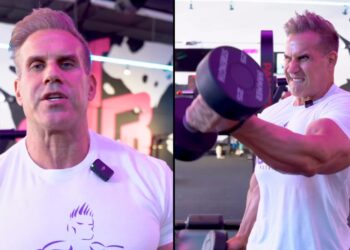The basic bodyweight push-up is a great exercise for building the chest, shoulders, and triceps. But there comes a point for a lot of us when it’s not as challenging anymore and the gains start slowing. That’s because there isn’t adequate stimulation or overload to force the muscles to adapt by getting bigger and stronger.
However, push-up variations such as the decline push-up is much more challenging and therefore will allow you to progress since you won’t be able to do as many repetitions.
Keep learning to learn how to do it with tips, variations, and helpful advice for incorporating it into your training regime.
Muscles Worked
The decline push-up as well as any push-up variation works several muscle groups at once since it’s a pushing exercise. Here are the details for each muscle involved.
Pectoralis Major Clavicular Head
The pectoralis also known as the chest muscles primary role is adduction and internal rotation of the arm as it moves via the shoulder joint. The clavicular head also causes flexion of the extended arm up to 90 degrees. This occurs when the arm moves up to shake someone’s hand.
Push-ups are a top choice for building the chest muscles and maybe the best bodyweight variation.
Level Up Your Fitness: Join our 💪 strong community in Fitness Volt Newsletter. Get daily inspiration, expert-backed workouts, nutrition tips, the latest in strength sports, and the support you need to reach your goals. Subscribe for free!
Pectoralis Major Sternal Head
The sternal head or the lower portion of chest fibers nearer to the nipples allows us to bring the arm down in front of the body. A good example is performing high to low cable chest flys.
Deltoid Anterior
Encapsulating the front part of the shoulder muscles, the deltoid anterior moves the arm up in front of the body. While we like to keep tension on the chest during push-ups, the front delts are heavily involved in similar pushing movements.
Triceps Brachii
The triceps muscles are grouped into three heads on the back part of your upper arm. While they have different lengths and shapes, the triceps brachii muscles allow us to push and extend the arm out straight. They get a solid workout from push-ups variations.
How To Do The Decline Push-Up
There are a few different ways to do this exercise although the general idea is the same. You want to elevate the feet, but you can use various heights to accomplish this and execution can and most likely vary between individuals.
Here are step-by-step instructions for how to perform this bodyweight exercise.
- Place your hands on the floor shoulder-width apart, then place your feet up onto your chosen platform or object at the height you find appropriate for your experience level.
- Adjust your hands so that the palms are under your lower chest.
- With your body in a straight line and butt lifted, pull your shoulders back and down and tense your core to maintain a rigid torso.
- Lower yourself as far down as you can and then press yourself back up until arms are extended. Focus on contracting the chest muscles as you push up.
- Repeat for the desired reps.
Here’s a video example of how-to, and not to do a decline push-up…
Decline Push-Up Tips
- The higher you elevate your feet, the more challenging the push-ups will be. If you’ve never done this push-up variation, start with your feet lower and elevate to increase the difficulty if needed.
- Make sure that your hands are positioned under your chest and not too far forward which would work more of the shoulders.
- Do not arch your round your back. You want to form a straight line with your body with your butt lifted to ensure you maintain a solid body position.
- Feel free to vary your hand width based on what’s most comfortable for you or to increase/decrease the difficulty.
3 Variations
The decline push-up is as good as it gets for increasing the difficulty of a push-up. However, there are other great variations too.
Pike push-up
This variation may shift more of the emphasis to the shoulders. However, it will still activate the chest and especially the upper area of the chest by the clavicle.
To do it:
- Place your hands and feet on the floor and lift your butt as high as you can to form an upside-down V with your body.
- Keep your head down and descend as far as you can by bending your elbows.
- Push yourself back up and repeat.
Dive bomber push-up
The dive bomber is kind of like a pike push-up and a basic push-up combined. However, you don’t want the hands and feet to be as close together as is the case with the pike push-up. It’s also going to be more challenging because there’s a lot more movement and support needed from the arms to properly perform this exercise.
It basically involves dipping under while moving the body forward and reversing the motion.
Level Up Your Fitness: Join our 💪 strong community in Fitness Volt Newsletter. Get daily inspiration, expert-backed workouts, nutrition tips, the latest in strength sports, and the support you need to reach your goals. Subscribe for free!
Here’s a short instructional video.
Hindu push-up
The Hindu push-up is similar to the dive bomber, however, you won’t reverse the motion by dipping backward. Instead, after the push-up part of the exercise where the hips are close to the ground, you’ll return to the starting position by keeping your body high off the ground.
Watch the video below to see it in action.
Related: 13 Next Level Push-Up Variations For Mass, Strength, and Performance
How To Incorporate The Decline Push-Up Into Your Training Routine
The decline push-up is the perfect bodyweight chest exercise whether you prefer to train at home with minimal to no equipment, in the park, or at the gym.
The order in which you perform the decline really depends on your level of training experience, goals, and availability of training equipment.
For example, if you’re doing a bodyweight-only session, the decline push-up should ideally be performed first before other push-up variations. This is because it’s arguably the most challenging push-up variation after the single-arm push-up.
So you’ll need to have enough strength to maximize your efforts. Not to mention, the upper chest area is oftentimes the most underdeveloped for most people so training it first makes total sense.
If you have access to weights or other resistance training tools, then do those exercises first before doing your push-ups, unless you find that the decline push-ups are as challenging as using weights or another form of resistance.
The goal should really be to have a predetermined rep range and aim for that in any given workout.
So for example, if decline push-ups are too easy for you, do them after your heavy bench presses. Otherwise, it may not matter how you incorporate them into your training regime.
Sets/reps
We recommend doing 3-4 sets of decline push-ups to failure. This will allow you to really maximize the stimulation of the chest and other muscles involved while being as proficient as possible with this staple bodyweight exercise.
Of course, you’ll ultimately have to determine an appropriate set and rep range based on your level of experience, workout routine, etc.
Related: 4 Advanced Bodyweight Chest Workouts At Home For Jacked Pecs
Wrapping Up
The decline push-up is simply one of the best ways to increase the difficulty of your push-ups, build more muscle, and increase upper body pressing strength. You’ll need a prop but it’s not hard to find a chair if training at home or a bench if working out at the gym.
Not to mention, there are other great variations that you can do if you can’t quite do the decline push-up or even if you want to change things up a little.
Interested in measuring your progress? Check out our strength standards for Bench Press, Push Ups, Cable Fly, and more.








